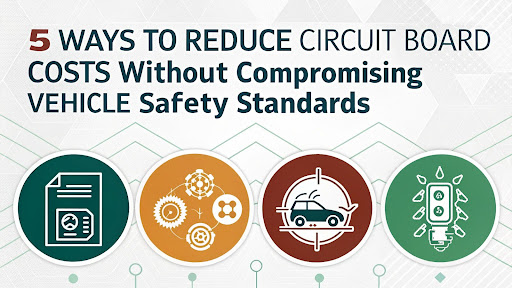5 Ways to Reduce Circuit Board Costs Without Compromising Vehicle Safety Standards
varsha June 18, 2025 0 COMMENTS
Even the most experienced tightrope walker would get uneasy in the continuous balancing act the automotive sector faces. One side of things is growing pressure to keep competitive in a market going more and more price sensitive and cut manufacturing costs. Conversely, there is a non-negotiable need to uphold the best safety criteria for road users and vehicle occupants alike. With circuit boards, this problem gets even more complicated since these electronic components are now found in everything from simple engine management to sophisticated driver assistance systems.
You are not alone if you are a manufacturer wrestling with this very conundrum, procurement specialist, or automotive engineer. The good news is that lowering circuit board costs doesn’t have to mean sacrificing safety standards. You can accomplish both goals at once with the correct tactics and strategy. Let’s investigate five tested techniques to maximize your circuit board costs while keeping strict safety standards intact.
Table of Contents
1. Perfect Your Strategy for Component Selection
The basis of reasonably priced circuit board design is smart component selection. Choose a strategic approach that fits component quality to particular application needs instead of automatically turning to premium components all around. This means being more discriminating about where premium components are really needed rather than sacrificing important safety features.
Analyze first the functional needs of your circuit in great detail. Safety-critical parts, including those regulating airbag deployment, steering aid, or braking systems, should never be sacrificed. Less important components, however, may perform perfectly with reasonably priced standard-grade substitutes.
Think about also the advantages of component standardization of your whole line of products. Using the same parts across several vehicle models or systems will help you negotiate great leverage with suppliers. By 20–30%, individual component costs can be lowered with volume buying power, which also simplifies supply chain management and lessens inventory complexity.
2. Accept Manufacturing Principles in Design
Circuit board cost control fits exactly the old adage “an ounce of prevention is worth a pound of cure.” Early in the development process, applying Design for Manufacturing (DFM) concepts will significantly lower manufacturing costs without affecting safety performance.
Emphasize designing solutions that reduce the number of special components and streamline assembly techniques. Unusual component orientations or tight spacing requirements in complex board layouts extend manufacturing time and error rates, both of which directly relate to increased costs. Easy manufacturing of boards helps to lower labor costs, increase yield rates, and lower the possibility of quality problems endangering safety.
Think of the manufacturing capacity of the production facility you have selected for your board design. Perfect matching of your manufacturer’s standard procedures will always be more economical than one needing specific tools or methods. These low-cost PCB assembly solutions guarantee the best value without compromising the dependability your automotive applications need.
3. Use Strategic Leverage of Advanced Materials
The performance and cost of your circuit boards depend much on the components used. Although high-performing materials like polyimide or ceramic substrates have outstanding qualities, they are not always required for every use. Selecting materials strategically lets you maximize expenses while yet upholding safety standards.
Standard FR-4 materials give sufficient performance for many automotive uses at a fraction of the cost of exotic substitutes. Save premium materials for uses requiring great mechanical strength or high-temperature environments close to the engine where their particular qualities are vital.
Likewise, giving your copper thickness needs great thought. Thicker copper layers raise material costs even if they offer better heat dissipation and current-carrying capability. Examine your real thermal limits and current requirements to find the lowest copper thickness that satisfies your safety criteria.
4. Team with the Correct Manufacturing Specialists
Your choice of manufacturing partner can either help or hinder your efforts at cost control. Working with an experienced automotive PCB manufacturer who is aware of both cost constraints and safety criteria gives you access to knowledge that could help you spot areas for possible savings.
Look for companies whose regular process includes value engineering tools. These collaborators will check over your designs and propose changes to cut expenses without sacrificing functionality. They might suggest manufacturing process changes that save money, layout tweaks, or different parts, depending on what would be most beneficial.
Long-term agreements with manufacturers also give consistency in price and priority access to capacity during times of maximum demand. Strong ties with a manufacturing partner help them to be involved in your success and more likely to collaborate with you to provide innovative ideas for cost control.
5. Execute Thorough Quality Assurance and Testing
Although it would seem contradictory to pay money for testing in order to cut expenses, thorough quality assurance really results in major long-term savings. Early identification of design or manufacturing problems stops expensive recalls, warranty claims, and reputation damage far beyond the cost of comprehensive testing.
Create a testing system that checks safety performance at several phases of manufacture as well as functionality. This covers final system validation, in-process testing during assembly, and component inspection arriving from sources. Although initially expensive, automated testing tools lower long-term testing expenses and yield more consistent results than hand testing techniques.
Think about using statistical process control techniques that track important variables all through manufacturing. This method enables you to spot trends suggesting possible quality problems, enabling you to solve problems before they cause expensive production delays or safety-compromising flaws.
Looking Ahead with Confidence
Maintaining vehicle safety standards and lowering circuit board costs at the same time is not only feasible but also necessary to stay competitive in the modern automotive market. The secret is to approach things methodically, thinking through the whole product lifetime—from initial design through final disposal.
Recall that, over time, the most affordable option is not always the lowest starting cost. Emphasize total cost of ownership—that is, manufacturing costs, quality problems, warranty claims, and possible recall expenses. Often over the lifetime of the product, a somewhat higher upfront investment in design optimization or manufacturing alliances yields significant savings.
The future of the automotive sector depends on manufacturers able to provide dependable, safe vehicles at reasonable rates. These five techniques will help you position yourself to achieve both goals.
RELATED ARTICLES
Latest Articles
 Jagermeister 750ml Price in India: Full …In Whisky Prices
Jagermeister 750ml Price in India: Full …In Whisky Prices Building a Scalable Payment Infrastructu…In Technology
Building a Scalable Payment Infrastructu…In Technology Tech-Savvy Ways to Streamline Your Finan…In Business
Tech-Savvy Ways to Streamline Your Finan…In Business Magic Moments Vodka Price in India: Size…In General
Magic Moments Vodka Price in India: Size…In General The Role of Claims Agencies in Holding A…In Tips
The Role of Claims Agencies in Holding A…In Tips How Embracing Cloud‑Native Strategies Tr…In Technology
How Embracing Cloud‑Native Strategies Tr…In Technology Poorvika Mobiles Pun: Best Place for You…In Technology
Poorvika Mobiles Pun: Best Place for You…In Technology Why Choosing the Right NEET Coaching Mak…In Education
Why Choosing the Right NEET Coaching Mak…In Education
stopie.com is a participant in the Amazon Services LLC Associates Program, an affiliate advertising program designed to provide a means for sites to earn advertising fees by advertising and linking to Amazon.com.
Clicking on an Amazon link from stopie.com does not increase the cost of any item you purchase.
We will only ever link to Amazon products that we think our visitors may be interested in and appreciate learning more about.



